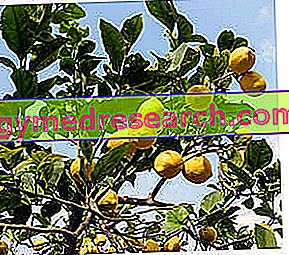Generality
With the term "lemon" it is possible to indicate both the plant and the fruit produced by it.
Lemon tree: the lemon is a citrus tree framed in the Rutaceae family, Genus Citrus, Species X limon (binomial nomenclature Citrus X limon ); with "X" we highlight the hybridization intervention.

Lemon is a medium-sized plant that can exceed 5m in height; produces very light shoots which, as they develop, give rise to dark green leaves. The flowers are white and evolve into yellow spherical fruits.
The lemon can have one or two blooms (on which both the productivity and the longevity of the plant depend, which turn out to be inversely proportional). The first is spring and allows the fruits to be harvested throughout the winter and spring (from November to May); the second is between August and September and makes it possible to obtain lemons from May onwards.
Lemon fruit: lemons are esperide-type fruits (for more information, see the article: Fruit - Notes on Botany, Classification and Types of Fruit). The color is bright yellow, the shape more or less globular and sometimes elongated, with a slight protuberance at the petiole.

Historical notes on lemons: on the basis of some research criteria (climatic belt, parasites and historical finds) scholars have gone back to the first zones of origin and spread of lemons, represented by the territories between southern China and the south-east valleys of India (home of most citrus fruits). The historical period of the manuscripts and paintings mentioning and depicting lemons goes back as far as 2500 years before the birth of Christ. Through the succession of commercial development, first with the Middle East and then with Greece, Europe and only recently (so to speak ...) with America, lemons have reached every corner of the temperate zone. On the Italian territory, lemons arrived around the 1st century AD (thanks to Roman trade), but the first crops date back only to the 11th century AD
Today, the lemon cultivars are concentrated above all in the sub-tropical zone of the globe with a constantly hot and humid climate. The country that holds the record of production and export of lemons is India, followed by Mexico and other central-southern American countries. In Italy, the areas with the greatest cultivation of lemons are the Sicilian, the Calabrese and the Campania; there is no lack of excellent citrus groves of the same fruit in Liguria and in the Lake Garda basin (where a town in the Brescia area has just acquired the name "Limone sul Garda").
Features and properties
WARNING! To consume the lemon peel in peace it is NECESSARY to rely on sources of supply that have products that are NOT treated!
Gastronomic characteristics of lemons: lemons are fragrant fruits with a strongly acrid and characteristic taste. The lemon is not usually "eaten" in pieces and the pulp juice is mainly used. To tell the truth, not even the latter is often "drunk" smooth and, usually, represents a condiment for side dishes and dishes, an ingredient in pastry and cooking, an agent of protein denaturation (marinating of meat or carpaccio fish or of very small size), a component of mixed fruit juices etc. Obviously, there are exceptions to the rule; certain subjects, tolerating well the very strong acidity of the citrus fruit, are able to consume it either in pieces (often still with peel) or in juice. By eating a lemon it is therefore possible to fully enjoy ALL the organoleptic and gustatory characteristics of the fruit. NB : using lemon juice instead of vinegar is one of the simplest but effective measures to increase the intake of vit. C in the daily diet and improve the absorption of food iron from plant sources.
The peel (epicarp) but not the albedo (mesocarp) is also very popular with lemons. The epicarp of lemons is the fraction of the fruit that contains the vast majority of the characteristic aroma; if deprived of the mesocarp (bitter), the peel of lemons becomes an exceptional ingredient for: pasta sauces, seasoning dishes, seasoning side dishes, composing desserts, producing candied fruit, etc.
Video Recipe - Homemade Lemon Syrup
Homemade lemon syrup
X Problems with video playback? Reload from YouTube Go to Video Page Go to Video Recipes Section Watch the video on youtubeSee other interesting video recipes based on lemons.
Phytotherapeutic aspects
The intoxicating aroma of lemons hides considerable chemical properties. The scent of lemons is due to the presence of essential oils, in particular limonene, and it seems that this molecule has good anti-tumor characteristics (further details are still in progress). Citroflavonoids ( hesperidin, diosmin and rutin ) also contribute to supporting the beneficial action of limonene as potent antioxidants, cholesterol-lowering agents, capillaroprotective and antineoplastic agents. Also in the herbalist field, the peel of lemons is used to promote digestion; assuming a decoction (commonly called " canary ") without sugar or other sweeteners, it is possible to benefit from the secretive increase of the exocrine glands attached to the digestive tract. An increase in salivation is in fact perceptible while, even more important but silent, is the improvement of the release of other enzymes in the subsequent phases of the process.
The lemons are also strongly thirst quenching, both for the content in water and for the concentration in mineral salts and citric acid.
Nutritional properties
Lemons are fruits that belong to the VII group of foods, as they are very rich in vitamin C (ascorbic acid). Furthermore, lemons contain high concentrations of water and excellent supply of mineral salts (potassium) and antioxidants in general (see the previous paragraph).
The nutritional concentration of lemons in energy molecules is negligible; both fats and proteins do not figure in noteworthy quantities and simple sugars, caloric molecules typical of other fruits, in lemons NOT constitute a substrate of similar importance.
Some argue that lemon juice can harm the mucous membrane of the stomach due to its marked acidity; to be sure, the stomach walls are organized to tolerate decidedly more aggressive pH and simple lemon juice cannot affect the integrity of a healthy mucosa. If a gastric pathology is already present, it is appropriate NOT to consume lemon or lemon juice between meals.
Given the high concentrations of citric acid, lemons are a strongly alkalizing food, indicated in purifying diets and in those aimed at preventing kidney stones from accumulation of cystine and uric acid.
Nutritional values
Nutritional composition for 100g of Lemons and Lemons, juice - Reference Values of Food Composition Tables - INRAN
 | |||
| lemons | Lemons, juice | ||
| Edible part | 64.0% | 100.0% | |
| water | 89.5g | 92.1g | |
| Protein | 0.6g | 0.2g | |
| Prevailing amino acids | - | - | |
| Limiting amino acid | - | - | |
| Lipids TOT | 0.0g | 0.0g | |
| Saturated fatty acids | - g | - g | |
| Monounsaturated fatty acids | - g | - g | |
| Polyunsaturated fatty acids | - g | - g | |
| Cholesterol | 0.0mg | 0.0mg | |
| TOT Carbohydrates | 2.3g | 1.4g | |
| Complex sugars | 0.0g | 0.0g | |
| Soluble sugars | 2.3g | 1.4g | |
| Dietary fiber | 1.9g | 0.0g | |
| Soluble fiber | - g | 0.0g | |
| Insoluble fiber | - g | 0.0g | |
| Power | 11.0kcal | 6.0kcal | |
| Sodium | 2.0mg | 2.0mg | |
| Potassium | 140.0mg | 140.0mg | |
| Iron | 0.1mg | 0.2mg | |
| Football | 14.0mg | 14.0mg | |
| Phosphorus | 11.0mg | 10.0mg | |
| Thiamine | 0.04mg | 0.02mg | |
| Riboflavin | 0.01mg | 0.02mg | |
| Niacin | 0.30mg | 0.20mg | |
| Vitamin A | 0.0μg | 0.0μg | |
| C vitamin | 50.0mg | 43.0mg | |
| Vitamin E | - mg | tr | |



